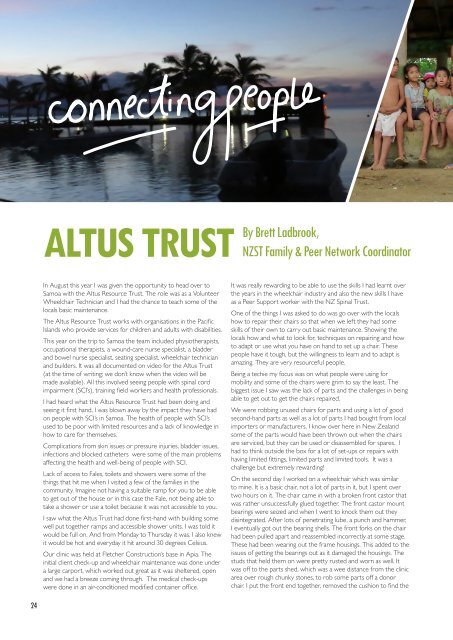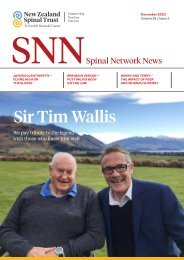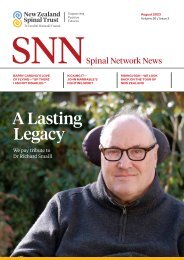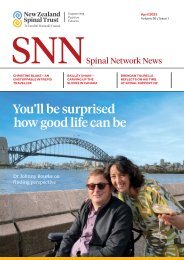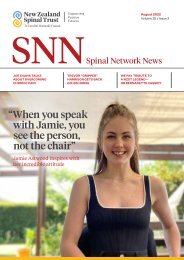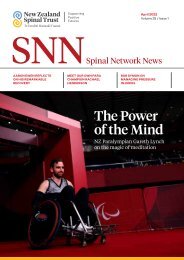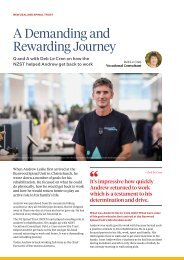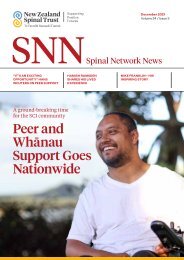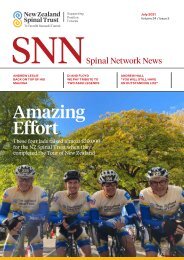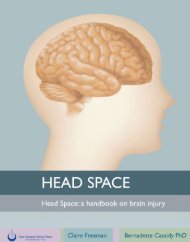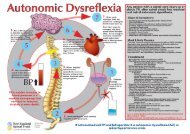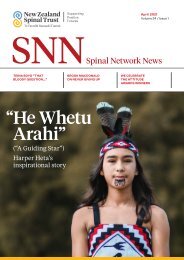SNN December 2018
Create successful ePaper yourself
Turn your PDF publications into a flip-book with our unique Google optimized e-Paper software.
ALTUS TRUST<br />
By Brett Ladbrook,<br />
NZST Family & Peer Network Coordinator<br />
In August this year I was given the opportunity to head over to<br />
Samoa with the Altus Resource Trust. The role was as a Volunteer<br />
Wheelchair Technician and I had the chance to teach some of the<br />
locals basic maintenance.<br />
The Altus Resource Trust works with organisations in the Pacific<br />
Islands who provide services for children and adults with disabilities.<br />
This year on the trip to Samoa the team included physiotherapists,<br />
occupational therapists, a wound-care nurse specialist, a bladder<br />
and bowel nurse specialist, seating specialist, wheelchair technician<br />
and builders. It was all documented on video for the Altus Trust<br />
(at the time of writing; we don’t know when the video will be<br />
made available). All this involved seeing people with spinal cord<br />
impairment (SCI’s), training field workers and health professionals.<br />
I had heard what the Altus Resource Trust had been doing and<br />
seeing it first hand, I was blown away by the impact they have had<br />
on people with SCI’s in Samoa. The health of people with SCI’s<br />
used to be poor with limited resources and a lack of knowledge in<br />
how to care for themselves.<br />
Complications from skin issues or pressure injuries, bladder issues,<br />
infections and blocked catheters were some of the main problems<br />
affecting the health and well-being of people with SCI.<br />
Lack of access to Fales, toilets and showers were some of the<br />
things that hit me when I visited a few of the families in the<br />
community. Imagine not having a suitable ramp for you to be able<br />
to get out of the house or in this case the Fale, not being able to<br />
take a shower or use a toilet because it was not accessible to you.<br />
I saw what the Altus Trust had done first-hand with building some<br />
well put together ramps and accessible shower units. I was told it<br />
would be full on. And from Monday to Thursday it was. I also knew<br />
it would be hot and everyday it hit around 30 degrees Celsius.<br />
Our clinic was held at Fletcher Construction’s base in Apia. The<br />
initial client check-up and wheelchair maintenance was done under<br />
a large carport, which worked out great as it was sheltered, open<br />
and we had a breeze coming through. The medical check-ups<br />
were done in an air-conditioned modified container office.<br />
It was really rewarding to be able to use the skills I had learnt over<br />
the years in the wheelchair industry and also the new skills I have<br />
as a Peer Support worker with the NZ Spinal Trust.<br />
One of the things I was asked to do was go over with the locals<br />
how to repair their chairs so that when we left they had some<br />
skills of their own to carry out basic maintenance. Showing the<br />
locals how and what to look for, techniques on repairing and how<br />
to adapt or use what you have on hand to set up a chair. These<br />
people have it tough, but the willingness to learn and to adapt is<br />
amazing. They are very resourceful people.<br />
Being a techie my focus was on what people were using for<br />
mobility and some of the chairs were grim to say the least. The<br />
biggest issue I saw was the lack of parts and the challenges in being<br />
able to get out to get the chairs repaired.<br />
We were robbing unused chairs for parts and using a lot of good<br />
second-hand parts as well as a lot of parts I had bought from local<br />
importers or manufacturers. I know over here in New Zealand<br />
some of the parts would have been thrown out when the chairs<br />
are serviced, but they can be used or disassembled for spares. I<br />
had to think outside the box for a lot of set-ups or repairs with<br />
having limited fittings, limited parts and limited tools. It was a<br />
challenge but extremely rewarding!<br />
On the second day I worked on a wheelchair which was similar<br />
to mine. It is a basic chair, not a lot of parts in it, but I spent over<br />
two hours on it. The chair came in with a broken front castor that<br />
was rather unsuccessfully glued together. The front castor mount<br />
bearings were seized and when I went to knock them out they<br />
disintegrated. After lots of penetrating lube, a punch and hammer,<br />
I eventually got out the bearing shells. The front forks on the chair<br />
had been pulled apart and reassembled incorrectly at some stage.<br />
These had been wearing out the frame housings. This added to the<br />
issues of getting the bearings out as it damaged the housings. The<br />
studs that held them on were pretty rusted and worn as well. It<br />
was off to the parts shed, which was a wee distance from the clinic<br />
area over rough chunky stones, to rob some parts off a donor<br />
chair. I put the front end together, removed the cushion to find the<br />
24


